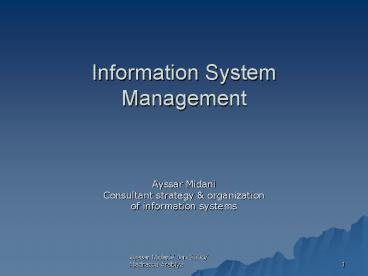Information System Management - PowerPoint PPT Presentation
1 / 23
Title:
Information System Management
Description:
Information system is the heart of the enntreprise. It contains all the entreprise ... Unicity. Referential constraints. Relationnal constraints. 27/01/2004 ... – PowerPoint PPT presentation
Number of Views:66
Avg rating:3.0/5.0
Title: Information System Management
1
Information System Management
- Ayssar Midani
- Consultant strategy organization
- of information systems
2
Information System ManagementGoals objectives
of MIS
- Information system is the heart of the
enntreprise - It contains all the entreprise information
semantics - Data dictionary or reference repositary contains
data description metadata
3
Information System ManagementGoals objectives
of MIS
- Must be Consistent
- Must be reliable
- Must be secured
- Must be available
- Performant
- Secured
- Protected
4
Information System ManagementGoals objectives
of MIS
- Definition of all system objects
- Constraints on theses objects
- Existence
- Unicity
- Referential constraints
- Relationnal constraints
5
Information System ManagementGoals
objectives of MIS
- Applications network security
- User groups description, their rights, on the
application system protectionagainst non
autorized access
6
Information System ManagementThe IS Repositary
- contains business objects
- Products, customers, product processing,contracts,
human resources, suppliers - All rules and processing description
- ?vital to maintain
- It must have management tools easy to use by a
functional expert (end user)
7
Information System ManagementIS repositary
- The dictionnary is the general repositary of all
applications 2cases of information system - ERP software
- Several applications
- Each application has its dictionnary
- General dictionary
- Dictionary could be an extention of design tools
(Mega, Graphtalk )
8
Entreprise Resource planning
- ERP Central Database central repository
Finance accounting
Sales marketing
dictionary
ERP database
Production materials management
Human resource
9
Information System ManagementThe data
administrator
- Data administrator is a functionnal expert
- Or a group of experts ( 1 for a main business
process) - Manages all business objects in the Data
dictionnary (creation, deletion, modification) - Manages the system users
- Priorities
- The reports
- ..
10
Information System ManagementDifferent levels IS
management
- Several applications
Entreprise repository
Application management
Functional level
application1
application2
application3
DB syst management
11
Information System ManagementDifferent levels IS
management
- Only ERP application
ERP application referential / application catalog
process management
Functional level
Sales management
.
Production
HRMS
DB syst management
12
Information System Managementdifferent levels IS
management
- Mixte ERP is one of the information system
objects
Entreprise Repository
Application management
Functional level
application1
application2
application3
ERP
ERP administration Functional techn
DB syst management
13
Information System ManagementThe data
administrator
- The data administrator is the person who
guaratees information consistency, reliability
and completeness - Manages the conceptual schema of applications
- manages the logical schema of applications
- Manages the logical views
14
Information System ManagementThe data
administrator
- Define all the objects of any application from
the design cycle of a project and during its life
- Object definitions
- Processing
- Application usage
- Constraint rules
- Interactions between objects
- Actors on the objects
15
Information System ManagementThe data
administrator
- Define users roles and habilitation
- Who has the right to access which application, to
do what, on which objects - Define, manages and gives rights on reports,
queries, statistics
16
Information System ManagementSystem network
administration
- System Architecture configuration, optimization
- Servers, clusters ,
- Datbases
- Networks, wan, internet,
- Users
- E-mail server
- Application servers
17
Information System ManagementSystem network
administration
- Basic Configuration
- Centralized Naming Concepts
- Usage and Configuration of Multi-Threaded Server
18
Information System ManagementSystem network
administration
- Usage and Configuration of Connection Manager
- Troubleshooting the Network Environment
- Security In the Network Environment
19
Information System ManagementSystem network
administration
- Describe the Application Architecture
- Select and implement appropriate data storage
structures - Design a schema
- Enforce business rules
- Load and extract data
20
Information System ManagementSystem network
administration
- Database Performance Tuning
- Alerts and Trace Files
- Utilities and Dynamic Performance Views
21
Information System ManagementSystem network
administration
- Tuning the Shared Pool
- Rollback Segment Tuning
- Monitoring and Detecting Lock Contention
- SQL Issues and Tuning Considerations for
Different Applications - Managing Mixed Workload
22
Information System ManagementSystem network
administration
- Using the available data access methods to tune
the physical design of the database. - Identify the demands of online transaction
processing systems (OLTP). - Identify the demands of decision support system.
- .
23
Questions ?































